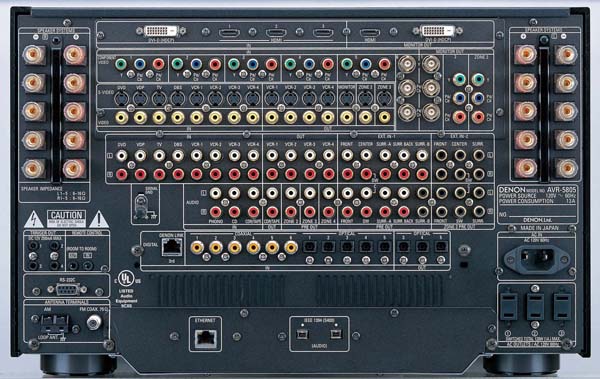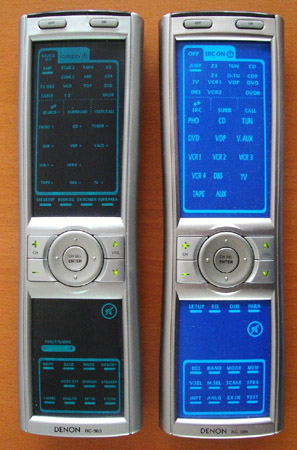|
On the Back
The rear is intimidating but has a logical layout. I particularly like the
left channel speaker posts on the “left” side of the receiver while the right
channel speaker posts are on the, you guessed it, the “right” side, as seen
when you bend over the front and reach the rear panel. You’ll
appreciate that as you lean over the unit when making connections, and you
can’t quite see back there without spinning the 97 pound chassis. All input
terminals are gold-plated, and the sturdy speaker posts can accept bare wire or
banana clips. I’ll get into all the connections available later.

Click on the photo above to see a larger version.
Between the speaker post arrays, there are rows of connections starting at the
top with a row of DVI and HDMI jacks: one each DVI- and HDMI-out and one
DVI- and three HDMI-in. Directly below is a row of five component-in video
connections, and a component-out. A second component out is provided for the
second zone. I’ll discuss the up-conversion later.
The video connections continue on the next row down with twelve S-Video and
twelve RCA
inputs corresponding to the source input, and three S-video outputs, two each
S-Video/RCA connections designated for additional zones 3 and 4.
There are eight audio inputs for video sources, from DVD to four VCRs. Not surprising,
there
are four audio outputs for VCR. Three additional audio inputs for audio sources such
as CD, phono, and CDR/tape are included.
The 5805 is equipped with two sets of analog external input terminals, one for
9.1 channels and the second for 5.1.
As a the 5805 can operate four separate zones, stereo pre-outs are provided for
Zones 2, 3, and 4, while the main zone has pre -uts for fronts, surrounds A and
B, center, and subwoofer. Because a second complete surround configuration is
available in Zone 2, an additional set of pre-outs purely for another room is
provided. Depending on how many channels (up to nine) and subs (you can actually
have three) wanted in the main zone, you’ll need to sacrifice surrounds B (by
connecting a line out for each sub) in a 7.1 setup. If you want the full
gamut - a 9.3 setup in the main room - you’ll give up the pre-outs in Zone 2.
Configure to your hearts content.
Four-12V trigger-outs are rated to deliver up to a very high 250 mA. Including
source, zone, and surround modes, the 5805 powerfully moves screens, drapes,
and whatever else you might want. The Denon 5805 is exceptional in this
department.
The 5805 has 3 AC outlets that are assignable for source and zone.
Denon recommends
speakers with impedance between 6 and 16 ohms. Although I can tell you I’ve
been running 4 ohm speakers for this review with hardly a glitch, I think Denon needs to re-think this issue especially for pricey flagship receivers
where consumers will spend more money on higher end speakers, usually rated at
lower impedances. It could be something as simple as a switch on the back for
8/6 ohms vs. 4 ohms.
The Technology
THX Certified and Dolby/DTS
The AVR-5805 is a THX Ultra2 certified receiver, meeting the strict standards
for power amplification and sleuth of other parameters THX demands before
they allow you to stamp their logo on your component. Mandatory is a pair of
back surround speakers, and THX promises to blend the sides and rear surrounds
for an optimized experience. Similarly, in Music mode. THX processing is
applied to 5.1 music sources (DTS or Dolby Digital) to improve the rear
soundstage. THX Game mode can be selected for operating either 5.1 or 2.0
sources.
It also features THX 4.0/5.1/6.1 post processing with additional DSP modes.
Along with all Dolby Digital processing, including EX, and Pro Logic IIx, the
5805
naturally has DTS ES Discrete 6.1, ES Matrix 6.1, and DTS 96/24 for
video processing. Throw in Dolby headphone capability.
Audyssey’s MultEQ XT
Truly the big breakthrough in this receiver is the Multi-EQ. Unlike the
AVR-3805, this is not a parametric EQ. Audyssey Laboratories licensed and
developed for Denon a first in room acoustic correction technology. It does
this
in two significant ways: first, it establishes a base curve for the room, and secondly, it
takes readings from multiple listening positions to calculate the best overall
settings. In fact, the process encourages taking
eight readings around your listening room.
The analysis is not unusual for a typical Auto-EQ
setup. It determines how many speakers you have, the size, correct phase,
satellites, or subwoofers. It also measures distance, speaker levels, and it
detects the proper crossover setting as well as corrects frequencies for all
listening positions.
Audyssey employs Texas Instrument DSP processors along with DACs to help it
define the best sound quality for your environment. Do keep in mind this can
all be disabled and recalled with a touch of a button on your remote, so you
can compare the sound with and without Auto-EQ.
The 5805 allows you to copy the base curve analysis and subsequent settings
configured by Audyssey and manually make your own adjustments, however this manual
setting would only apply to one sweet spot.
Audio Processing
The AVR-5805 is equipped with Denon’s DDSC, (Dynamic Discrete Surround
Circuit). For surround sound, Denon employs high quality Burr Brown PCM-1792
24-bit/192 KHz DACs for all 16 channels and 32-bit floating point DSPs for
both the main and second zones.
Denon’s exclusive Alpha technology, also know as AL24, digitally upsamples for
the first time from 16-bit to 24-bit from all source signals, allowing the “DA
converters to work at the highest capacity”.
Video Processing
Faroudja’s integrated video scaling using DCDi (Directional Correlation
De-interlacing) technology and 12-bit/216 MHz video DACs to upconvert
interlaced 480i sources to 480p, 720p, and also 1080i.
The HDMI firmware software is currently version 1.1
IEEE 1394 and Ethernet Connectivity
Denon uses BridgeCo.’s processor/firmware components for IEEE1394 and Ethernet
connectivity. Although it’s already used by Denon for the DVD-5900 and
DVD-3910, the AVR-5805 is the first Denon receiver to support Ethernet
connectivity, with two ports supplied. What this means is through one single
FireWire or I Link, all audio formats can stream from those Denon DVD players
to the receiver. Indeed, this makes the Denon compatible with any other
manufacturer’s components that feature this industry design standard.
Of course, the other main application here is the interaction with your PC, as
the 5805 is capable of playing compressed MP3 and WMA audio files directly
from your computer.
Denon Link 3
Those with issues about Denon’s proprietary Link technology might find some
comfort in knowing that Link 3 can now pass SACD signals digitally, unlike the
predecessor Link 2. Although there is now an agreement in place, switching
this process on will still take some time, which the AVR-5805 is capable of
delivering through an upgrade.
Future Connectivity
As I’ve mentioned, the future capabilities of the 5805 are not totally known at
this time; however look for internet radio and PC compatibility, such a song
lists, genre, and type streaming on the OSD of the receiver. We are not
necessarily talking about satellite radio sources, XM, or Sirius radio, yet.
The soon to be released AVR-4806 will be XM-ready however.
More things are to come we’re assured, but Denon isn’t ready to talk about
them. I’m told a microprocessor reset is one idea.
The
Remote Control
The remote control supplied with the AVR-5805 is the same that comes with the
AVR-3805, Denon’s RC-995 universal learning Electro-Luminescence remote
control, with a few improvements. Obviously the 995 is upgraded to handle the
increased demands of the 5805, more zones, user modes, and Audyssey EQ.
However the improvements are in the operations of the remote. First, the
color is blue, not the aqua from the previous model, which is much easier to
see. Secondly, the text is much larger, a big improvement as far as I’m
concerned. The chassis of the unit is identical, satin finished and about 9”
long. All the same features: An automatically lit display when the unit is
moved, which can be set to stay on in 5 second increments, set-up, source, and
volume levels, inputs, etc. for all four zones.
The photo on the right illustrates the remote previously
supplied with the AVR-3805 (shown on the left), and the improved version
included with the AVR-5805 (shown on the right).
Click Here to Go to Part III
Terms and Conditions of Use

|





